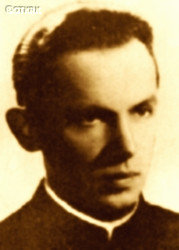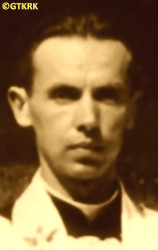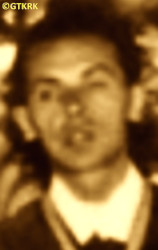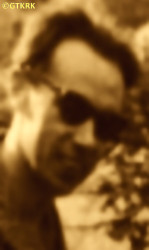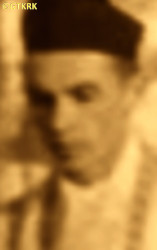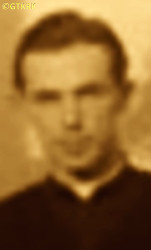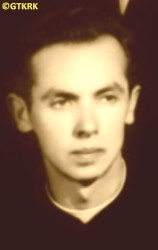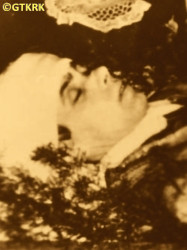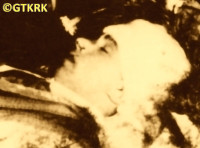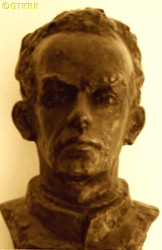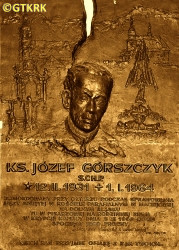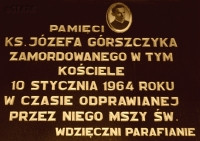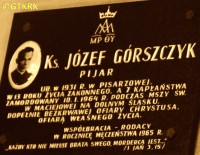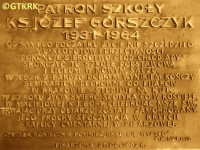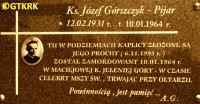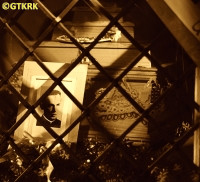Roman Catholic
St Sigismund parish
05-507 Słomczyn
85 Wiślana Str.
Konstancin deanery
Warsaw archdiocese, Poland
full list:
displayClick to display full list

searchClick to search full list by categories
wyświetlKliknij by wyświetlić pełną listę po polsku

szukajKliknij by przeszukać listę wg kategorii po polsku

Martyrology of the clergy — Poland
XX century (1914 – 1989)
personal data
surname
GÓRSZCZYK
forename(s)
Joseph (pl. Józef)
religious forename(s)
Josefa (pl. Józefa)
function
religious cleric
creed
Latin (Roman Catholic) Church RCmore on
en.wikipedia.org
[access: 2014.09.21]
congregation
Order of Poor Clerics Regular of the Mother of God of the Pious Schools SPmore on
en.wikipedia.org
[access: 2013.05.19]
(i.e. Piarists, Scolopi, Escolapios)
diocese / province
Wrocław archdiocesemore on
en.wikipedia.org
[access: 2013.05.19]
date and place
of death
10.01.1964

Cieplice Śląskie‐Zdrójtoday: district of Jelenia Góra, Jelenia Góra city pov., Lower Silesia voiv., Poland
more on
pl.wikipedia.org
[access: 2022.01.12]
details of death
During novitiate and studies in Kraków, under surveillance by the Polish branch of the Russian KGB, i.e. the Commie‐Nazi SB.
Attacked with an ax while celebrating Mass in the church in Maciejowa, by a former — during World War II — forced laborer in Austria, where he was supposed to go from Latvia, where found himself in 1939 (according to some sources, a repatriate from Ukraine).
The murderer struck two blows in the forearm near the elbow, and three in the parieto–occipital region of the head; the victim also received several other minor injuries.
Taken — with an ax still in his head — to the hospital in Cieplice, where died a few minutes later.
There is a suspicion that the death had a political context, and that the Commie‐Nazi SB was responsible.
cause of death
murder
perpetrators
Russians / Poles
sites and events
Ribbentrop‐MolotovClick to display the description, Pius XI's encyclicalsClick to display the description
date and place
of birth
12.02.1931

Pisarzowatoday: Limanowa gm., Limanowa pov., Lesser Poland voiv., Poland
more on
en.wikipedia.org
[access: 2022.01.28]
religious vows
31.08.1952 (temporary)
02.02.1956 (permanent)
presbyter (holy orders)
ordination
21.12.1957

positions held
1963 – 1964
friar and parish vicar — Cieplice Śląskie‐Zdrójtoday: district of Jelenia Góra, Jelenia Góra city pov., Lower Silesia voiv., Poland
more on
pl.wikipedia.org
[access: 2022.01.12] ⋄ monastery, Piarists SP ⋄ Maciejowatoday: district of Jelenia Góra, Jelenia Góra city pov., Lower Silesia voiv., Poland
more on
en.wikipedia.org
[access: 2022.01.12], St Peter and St Paul the Apostles RC parish ⋄ Jelenia Góratoday: Jelenia Góra city pov., Lower Silesia voiv., Poland
more on
en.wikipedia.org
[access: 2022.01.12] RC deanery
1962 – 1963
friar — Cieplice Śląskie‐Zdrójtoday: district of Jelenia Góra, Jelenia Góra city pov., Lower Silesia voiv., Poland
more on
pl.wikipedia.org
[access: 2022.01.12] ⋄ monastery, Piarists SP — also: pastor of churches in Staniszów, Komarne and Dziwiszów
1959 – c. 1962
friar — Łowicztoday: Łowicz urban gm., Łowicz pov., Łódź voiv., Poland
more on
en.wikipedia.org
[access: 2021.12.18] ⋄ monastery, Piarists SP — replacement (the Piarists returned to Łowicz in 1958)
1957 – 1959
student — Lublintoday: Lublin city pov., Lublin voiv., Poland
more on
en.wikipedia.org
[access: 2021.08.20] ⋄ biblical science, Department of Theology, Catholic University of Lublin KUL [i.e. Catholic University of Lublin KUL (since 1928) / clandestine Catholic University of Lublin KUL (1939‐1944) / University of Lublin (1918‐1928)] — i.a. Greek and Latin studies, resident in Lublin, studies interrupted for personal reasons; also: learning Hebrew, English, Arabic and Aramaic: in total learned 15 languages
1957 – 1959
friar — Hebdówtoday: Nowe Brzesko gm., Proszowice pov., Lesser Poland voiv., Poland
more on
en.wikipedia.org
[access: 2022.12.21] ⋄ monastery (post‐Premonstratensians (previously an abbey)), Piarists SP — formal assignment; periodically: chaplain in the villages of Pławowice and Sierosławice
till c. 1957
friar — KrakówRakowice
today: part of District III Prądnik Czerwony and District XIV Czyżyny, Kraków city pov., Lesser Poland voiv., Poland
more on
en.wikipedia.org
[access: 2022.12.21] ⋄ monastery, Piarists SP
1952 – 1957
student — KrakówStradom, part of Stare Miasto I District
form.: village
today: Kraków city pov., Lesser Poland voiv., Poland
more on
en.wikipedia.org
[access: 2021.06.07] ⋄ philosophy and theology, Veterinary Institute [i.e. Veterinary Institute (from 1944) / Germ. Staatliche Tierarztliche Institut (State Veterinary Institutes) (1942‐1944) / Veterinary Institute (1939‐1941) / Academy of Veterinary Medicine (1922‐1939) / Imperial–Royal Veterinary School (1889‐1922)]
26.08.1951 – 31.08.1952
novitiate — KrakówRakowice
today: part of District III Prądnik Czerwony and District XIV Czyżyny, Kraków city pov., Lesser Poland voiv., Poland
more on
en.wikipedia.org
[access: 2022.12.21] ⋄ monastery, Piarists SP — service as a monastery kitchen helper and beekeeper
1951
accession — KrakówRakowice
today: part of District III Prądnik Czerwony and District XIV Czyżyny, Kraków city pov., Lesser Poland voiv., Poland
more on
en.wikipedia.org
[access: 2022.12.21] ⋄ monastery, Piarists SP — after matura exam in Nowy Sącz in 06.1951
sites and events
descriptions
Ribbentrop‐Molotov: Genocidal Russian‐German alliance pact between Russian leader Joseph Stalin and German leader Adolf Hitler signed on 23.08.1939 in Moscow by respective foreign ministers, Mr. Vyacheslav Molotov for Russia and Joachim von Ribbentrop for Germany. The pact sanctioned and was the direct cause of joint Russian and German invasion of Poland and the outbreak of the World War II in 09.1939. In a political sense, the pact was an attempt to restore the status quo ante before 1914, with one exception, namely the „commercial” exchange of the so‐called „Kingdom of Poland”, which in 1914 was part of the Russian Empire, fore Eastern Galicia (today's western Ukraine), in 1914 belonging to the Austro‐Hungarian Empire. Galicia, including Lviv, was to be taken over by the Russians, the „Kingdom of Poland” — under the name of the General Governorate — Germany. The resultant „war was one of the greatest calamities and dramas of humanity in history, for two atheistic and anti‐Christian ideologies — national and international socialism — rejected God and His fifth Decalogue commandment: Thou shall not kill!” (Abp Stanislav Gądecki, 01.09.2019). The decisions taken — backed up by the betrayal of the formal allies of Poland, France and Germany, which on 12.09.1939, at a joint conference in Abbeville, decided not to provide aid to attacked Poland and not to take military action against Germany (a clear breach of treaty obligations with Poland) — were on 28.09.1939 slightly altered and made more precise when a treaty on „German‐Russian boundaries and friendship” was agreed by the same murderous signatories. One of its findings was establishment of spheres of influence in Central and Eastern Europe and in consequence IV partition of Poland. In one of its secret annexes agreed, that: „the Signatories will not tolerate on its respective territories any Polish propaganda that affects the territory of the other Side. On their respective territories they will suppress all such propaganda and inform each other of the measures taken to accomplish it”. The agreements resulted in a series of meeting between two genocidal organization representing both sides — German Gestapo and Russian NKVD when coordination of efforts to exterminate Polish intelligentsia and Polish leading classes (in Germany called «Intelligenzaktion», in Russia took the form of Katyń massacres) where discussed. Resulted in deaths of hundreds of thousands of Polish intelligentsia, including thousands of priests presented here, and tens of millions of ordinary people,. The results of this Russian‐German pact lasted till 1989 and are still in evidence even today. (more on: en.wikipedia.orgClick to attempt to display webpage
[access: 2015.09.30])
Pius XI's encyclicals: Facing the creation of two totalitarian systems in Europe, which seemed to compete with each other, though there were more similarities than contradictions between them, Pope Pius XI issued in 03.1937 (within 5 days) two encyclicals. In the „Mit brennender Sorge” (Eng. „With Burning Concern”) published on 14.03.1938, condemned the national socialism prevailing in Germany. The Pope wrote: „Whoever, following the old Germanic‐pre‐Christian beliefs, puts various impersonal fate in the place of a personal God, denies the wisdom of God and Providence […], whoever exalts earthly values: race or nation, or state, or state system, representatives of state power or other fundamental values of human society, […] and makes them the highest standard of all values, including religious ones, and idolizes them, this one […] is far from true faith in God and from a worldview corresponding to such faith”. On 19.03.1937, published „Divini Redemptoris” (Eng. „Divine Redeemer”), in which criticized Russian communism, dialectical materialism and the class struggle theory. The Pope wrote: „Communism deprives man of freedom, and therefore the spiritual basis of all life norms. It deprives the human person of all his dignity and any moral support with which he could resist the onslaught of blind passions […] This is the new gospel that Bolshevik and godless communism preaches as a message of salvation and redemption of humanity”… Pius XI demanded that the established human law be subjected to the natural law of God , recommended the implementation of the ideal of a Christian state and society, and called on Catholics to resist. Two years later, National Socialist Germany and Communist Russia came together and started World War II. (more on: www.vatican.vaClick to attempt to display webpage
[access: 2023.05.28], www.vatican.vaClick to attempt to display webpage
[access: 2023.05.28])
sources
personal:
www.katolik.plClick to attempt to display webpage
[access: 2014.11.28], www.iap.plClick to attempt to display webpage
[access: 2014.11.28], www.pisarzowa.plClick to attempt to display webpage
[access: 2019.02.02], gosc.plClick to attempt to display webpage
[access: 2014.11.28], nowahistoria.interia.plClick to attempt to display webpage
[access: 2019.02.02]
original images:
mtrojnar.rzeszow.opoka.org.plClick to attempt to display webpage
[access: 2014.11.28], www.pisarzowa.plClick to attempt to display webpage
[access: 2019.02.02], www.pisarzowa.plClick to attempt to display webpage
[access: 2019.02.02], www.pisarzowa.plClick to attempt to display webpage
[access: 2019.02.02], www.pisarzowa.plClick to attempt to display webpage
[access: 2019.02.02], www.pisarzowa.plClick to attempt to display webpage
[access: 2019.02.02], www.pisarzowa.plClick to attempt to display webpage
[access: 2019.02.02], gazetakrakowska.plClick to attempt to display webpage
[access: 2019.02.02], www.pisarzowa.plClick to attempt to display webpage
[access: 2019.02.02], www.pisarzowa.plClick to attempt to display webpage
[access: 2019.02.02], i2.wp.comClick to attempt to display webpage
[access: 2019.02.02], www.tp-jg.ovh.orgClick to attempt to display webpage
[access: 2021.12.19], i2.wp.comClick to attempt to display webpage
[access: 2019.02.02], www.pisarzowa.plClick to attempt to display webpage
[access: 2019.02.02], rzeszow.pijarzy.plClick to attempt to display webpage
[access: 2019.02.02], gosc.plClick to attempt to display webpage
[access: 2014.11.28]
LETTER to CUSTODIAN/ADMINISTRATOR
If you have an Email client on your communicator/computer — such as Mozilla Thunderbird, Windows Mail or Microsoft Outlook, described at WikipediaPatrz:
en.wikipedia.org, among others — try the link below, please:
LETTER to CUSTODIAN/ADMINISTRATORClick and try to call your own Email client
If however you do not run such a client or the above link is not active please send an email to the Custodian/Administrator using your account — in your customary email/correspondence engine — at the following address:

giving the following as the subject:
MARTYROLOGY: GÓRSZCZYK Joseph
To return to the biography press below:
 Click to return to biography
Click to return to biography








